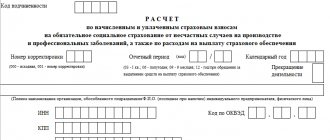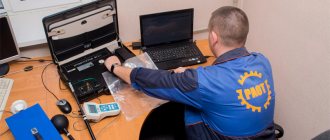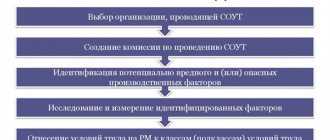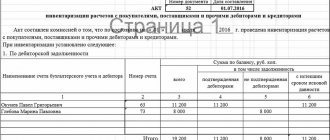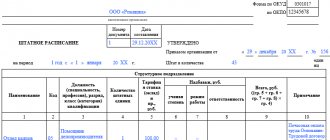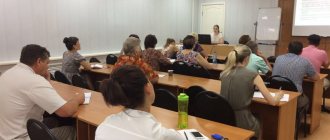Home / Labor Law / Personnel Management / Personnel training and certification
Back
Published: 08/09/2016
Reading time: 7 min
0
748
The Constitution gives citizens of the Russian Federation not just the right to get a job, but also the opportunity to carry out work in decent conditions that meet all basic safety and sanitary requirements.
Ensuring such conditions is one of the main responsibilities of any employer imposed on it by labor legislation.
In order to verify the compliance of the workplaces equipped by the employer with the basic requirements, the state conducts regular certification of all persons engaged in commercial and production activities, with the exception of individuals who have organized private business activities and are individuals.
- Legislation
- Goals and criteria for certification
- Requirements for inspectors
- Order of conduct
- How are the results presented?
- What should the employer do after receiving the results?
Certification, what is it
This concept is from the section of labor legislation. Denotes the identification of compliance of the environment and other factors at a person’s place of work with labor safety standards, for harmful and dangerous indicators.
If these factors are detected, the employer is obliged to develop an algorithm of actions to bring working conditions closer in accordance with these standards.
The phrase “job certification” was actively used until 2013; already in 2014, the definition of “special assessment” came to replace it.
The very concept and rules for its implementation are supported by Federal Law No. 426 of December 28, 2013. The main thing in this action is a set of techniques for detecting and assessing the harmfulness and danger of production indicators and the degree of their impact on human health.
Why is certification needed and is it needed at all? This procedure is carried out to divide all production factors into classes and subclasses according to the degree of negative impact on human health.
This division plays a big role in the lives of many workers. Employees engaged in the labor process with negative working conditions can count on a reduction in their length of service in order to receive a pension and receive benefits.
Certification allows you to give a full assessment of each workplace from several sides, its goals:
- Assess the degree and level of how factors in the working environment influence a person.
- Identify the severity and intensity of individual production cycles on the employee’s health.
- Determine the level of injury and its safety.
- Determine the provision of special clothing for each hired employee for life-threatening jobs.
The result of such an assessment is the completion of a certification card, which forms the basis for the development of measures to reduce injuries at the enterprise.
Completion of SOUT
An order is issued to complete the inspection.
The experts have done a lot of work, and then we need to summarize the results of the certification:
- A scheduled meeting is held at which all controversial issues are discussed and after the members of the commission and representatives of the expert organization come to a consensus, the manager gives instructions to formalize the results;
- An administrative document on completion of work is issued;
- SOUT maps and an action plan to eliminate comments are being drawn up, a general list of places that were assessed by experts is being compiled;
- SOUT cards are signed by all members of the commission;
- The employer introduces the cards to employees and confirms them with their signature.
The listed requirements must be met in full. Certification cards are stored in the organization that carried out the work and at the enterprise where the certification was carried out.
The duration of storage is set in accordance with the employer's office management instructions, but in any case, the cards must be at the enterprise until the work of the next certification commission is completed.
Who is subject to special assessment of working conditions?
Special certification of workplaces applies to all categories of employers.
These include:
- Legal entities regardless of type of ownership;
- Commercial firms;
- Budgetary institutions;
- Individual entrepreneurs with at least one employee.
Only individual entrepreneurs who do not have employees, as well as individuals who have civilian employment, but do not register them properly, are not subject to this procedure.
Payment to specialists conducting certification is made only from the accounts of enterprises and institutions that have undergone such verification, as stipulated in the Labor Code, Art. 212.
Meaning of the procedure
For the head of an organization, worker certification is an opportunity to optimize the use of labor. The employer can determine the level of qualifications not only of each individual employee, but also of the entire staff as a whole. Based on the results obtained, the manager creates additional incentives for the professional growth of employees and improvement of their qualifications. It is also important that the manager gets the opportunity to create a personnel reserve, including the most competent specialists. The results of the inspection are the basis for terminating a contract with employees whose qualifications do not meet the requirements established for the relevant position.
For workers, certification is an opportunity to prove that they are competent specialists with the qualifications and professionalism sufficient to perform a larger volume of work or more complex tasks. Accordingly, they can count on a promotion or salary increase.
Procedure for certification of workplaces
The process of determining the level of occupational hazards can be carried out in several ways:
- It is carried out only at the expense of the employer. Large enterprises can do this.
- The entire range of work is carried out by a third-party company, whose competence is the certification of workplaces. It must be certified and have the appropriate license.
- Conducted jointly. Financial and preparatory work is carried out by specialists of the audited organization, and measurements are carried out by a third-party company.
All of the listed works are regulated by the “Regulations on the Rules for Certification” adopted by the Ministry of Labor and Social Affairs. development of the Russian Federation and entered into force on July 1, 1997. Amendments were made only on September 1, 2008.
The entire special assessment process can be represented in several stages:
- Preparation for assessment work.
- The main one, which lies in the verification itself.
- Final, development of final documents with records of the results of all research
- Evaluation of the results obtained during the procedure.
- Preparation for certification of the organization based on the results of the audit.
Let's look at each stage in more detail.
Preparation
The head of an institution that is subject to a special assessment of workers appoints his employee as the chairman of the commission. He, in turn, selects his team. Basically, a person responsible for occupational safety and health at work is appointed to the position of chairman; this may be an occupational safety engineer (OHS).
In any company or organization, the certification commission includes:
- OT Engineer;
- HR employee;
- Mechanic;
- Electrician or power engineer;
- Payroll accountant;
- Honey. worker;
- Member of a trade union organization;
- Technologist.
The number of people can be determined individually; such a rule is not specified in regulations for assessing conditions.
Such a composition can be observed in small institutions, and in large companies such commissions should be present in all individual divisions with a central commission at the head.
Each list of employees for workplace certification is approved by order on the main activity, indicating the full name, position of the chairman and members of the commission, as well as the timing of the inspection.
All representatives undergo training. To do this, the chairman must invite a specialist from a regional organization on occupational safety to conduct methodological lessons. The seminar can last for two days.
The recommended training program is typically 20 hours, after which students are issued a certificate of completion of the OT course. After which the commission can begin certification.
The next action on the part of the commission is to develop a schedule of events. At this stage, the timing and stages of certification are determined, indicating authorized persons.
Next, a list of workplaces that are subject to assessment is determined, indicating harmful and dangerous factors for the main measurements. When compiling the register, workers rely on the staffing table and the “General Classification of Occupations”, and identify the types of work that are most susceptible to the negative impact of factors.
They mainly refer to employee complaints, for example, lack of air ventilation in the room, vibration, loud noise.
Documentation of the list is presented in the form of a table and plays an important role in the overall certification procedure, since it determines the scope of the entire certification work.
And the last step of this stage is the collection and systematization of complete information about each workplace, its environmental factors, as well as the preparation of a regulatory framework regulating a special assessment of the risk of injury to a person and providing him with personal protective equipment (PPE).
Main stage
Certification is aimed at identifying the compliance of work factors with state occupational safety standards in a number of areas:
- Compliance with hygiene standards;
- Risk of injury in the workplace;
- Availability of protective clothing, gloves, boots, respirators, and goggles for workers;
- Comprehensive assessment of all conditions.
The assessment, according to hygienic criteria, takes into account all dangerous and harmful factors, the degree of severity, and tension. It can also be biological, physical, chemical factors. It is carried out with special measuring instruments. The results identified as a result of measurements are documented in a protocol.
The protocol includes the following data:
- Date of measurements.
- Identification of the unit being assessed.
- Name of measuring instruments.
- Name of the factor being measured.
- A drawing of the room in which measurements were taken indicating the exact location.
- Standard value of the measured factor for further comparison.
- Autograph of the person responsible for the measurement.
- Stamp and signatures of employees of a third-party organization, if one is involved.
Only specialized companies own measuring instruments, and the risk of injury is checked by specialists from their own commission.
When assessing injuries, power, machine tools, accessories and working tools, special clothing, timeliness of instruction are checked, as well as their compliance with regulatory standards and the availability of safety certificates for automated mechanisms.
When assessing PPE, the correctness and complete provision of workers with them at each workplace is checked. Before assessing the availability of PPE, the commission must study and draw up protocols for the above stages in order to determine what equipment is necessary to have at the enterprise and whether they are fully available.
The outcome of the job evaluation must be recorded. Based on the data obtained and comparing them with standards, the class, subclass of difficulty of being in the workplace, the hazard class, and the compliance of the place of work with safety standards are determined.
All research results are recorded in a special map, on the basis of which an action plan to improve the climate in the workplace is developed.
Attestation card
The map is a final document that confirms the actual situation at each certified site, current benefits and compensation for employed people, standards for issuing personal protective equipment, and a number of measures to eliminate or minimize undesirable performance indicators.
With the help of the assessment document, places are identified that have not passed the assessment, that is, do not meet safety standards, and a list of poor indicators in production is determined, which are subsequently used when applying for a position, in order to inform the person about the conditions of future work.
Final
Involves preparing output documents:
- A register of workplaces with the results of inspections separately by structural units and as a whole, indicating the number of workers and the provision of their special clothing.
- Protocols for compliance with various OT requirements.
- Work plan to eliminate identified violations.
All documents must be signed by the commission members and the chairman. The results of the certification should be communicated to the entire team, with the deadlines for completion announced. The results of such verification are stored for 45 years and are strict reporting forms.
Legislation
Providing appropriate conditions for work is the responsibility of employers on the basis of Article 56 of the Labor Code. This is a very important point, since the health and even the lives of working citizens depend on the responsibility of managers.
To eliminate discrepancies, the Ministry of Labor and Social Development issued a separate Order in April 2011 under number 342N, which approved the procedure for conducting certification activities.
The last edition of the order was made in December 2012 and in its updated form this document is still in effect.
What work must be certified
Mandatory assessment is carried out for compliance with safety standards when using manual mechanisms, automated devices and equipment that may be exposed to harmful and dangerous factors.
Such criteria do not apply to a special assessment of working conditions; it has no restrictions. That is, it is carried out regardless of the above indicators.
Until 2014, remote workers or homeworkers were subject to certification. And what about office workers? Today, Law 426 provides for the assessment of the workplace of an office worker on a general basis.
Who provides employee certification services - review of the TOP 3 companies
Is the personnel certification procedure causing you difficulties and you don’t know where to start? I suggest turning to professionals.
We have selected companies that will quickly and efficiently certify workers in any field, including education, medicine, government and social services.
1) HR PRACTICE
“HR-praktika” is a St. Petersburg company that has been operating throughout the Russian Federation in the field of personnel management for more than 20 years. During this period, the company became an expert in the field of its professional interests.
The company provides services in the field of personnel management in the following areas:
- audit;
- outsourcing;
- education;
- consultations;
- design work.
Managers and business owners, job seekers and company employees, HR specialists - everyone will find useful information on the corporate Internet resource. You can get an initial consultation by phone or by leaving a request on the website.
2) Hermes
"Hermes" is a licensing center based in Moscow, created in 2006. The company has all the necessary certificates and licenses to carry out the declared activities.
:
- quality management certification;
- licensing;
- SRO approvals;
- training and retraining courses in various areas;
- certification: personnel, certification of workplaces according to working conditions;
- sale of ready-made companies with a license from the Ministry of Emergency Situations and KGIOP.
3) There are stills!
Having started its activities back in 2006 as a division of the holding, it became a separate business unit with a wide network of specialized agencies.
Recruiting and consulting services are the main activities of the company. Personnel certification and special assessment of working conditions became the most popular among clients.
The results of the events carried out by highly qualified specialists of the agency “There are Personnel!” allow customers to:
- identify the reasons for ineffective staff performance;
- determine directions for optimizing personnel and organizational work;
- develop activities that increase motivation and productivity;
- review job responsibilities and salaries;
- redistribute the workload among specialists.
Certification terms
According to the rules of mandatory certification, testing to ensure that working conditions comply with safety standards is carried out once every 5 years. But there are times when an unscheduled inspection is coming, which can be carried out ahead of schedule.
- Unscheduled revaluation may be associated with the commissioning of new production facilities, which leads to the attraction of new labor, changes in production technology and the emergence of new working factors.
- Another point for an unscheduled inspection may be the occurrence of an accident or occupational disease that occurs in the presence of harmful and dangerous factors.
- At the request of the labor inspectorate.
- At the request of employees and representatives of the organization's trade union.
In general, the average duration of certification is five years.
Job Descriptions
Professional standards are the legal basis for the development of job descriptions. These documents, in addition to the direct responsibilities and rights, as well as the functions of a specific employee, set out the requirements for the level of qualifications and work experience, education and other requirements, compliance with which is necessary to fulfill the assigned tasks in a specific position. For example, computer skills are important for a secretary.
The one who conducts the certification of workers checks precisely the compliance of the skill level with the requirements established in the job description.
The manager must define the requirements for experience and length of service, as well as education and professional skills for a specific position in a uniform and clear manner. Otherwise, problems may arise after certification (for example, challenging the results discussed above).
Innovations in 2021
Radical changes took place in 2014. According to the law, the name of the procedure has changed. Previously, certification of workplaces, now the concept of special assessment of working conditions is used.
Since 2015, all employers have been required to report on a special assessment to the Social Insurance Fund authorities in order to assign a class of conditions, which is necessary for submitting reports to the Pension Fund authorities.
Those organizations that were certified before 2021 must be recertified until December 31, 2021.
According to a letter from the Ministry of Labor of the Russian Federation, such certification should be considered invalid and currently it is necessary to undergo a special assessment of working conditions for compliance with hygiene and injury safety standards.
However, not all companies rushed to comply with the requirements of the Federal Law on time. Information about violators is currently summarized in electronic format and is under analytical review by inspectors from the Prosecutor's Office of the Russian Federation and the State Labor Inspectorate, which will make it possible, in the future, to apply penalties to entrepreneurs without going to the “place.”
The fines are now significant:
| Type of violation | Amount of fine |
| Violation of deadlines, that is, untimeliness or failure of unscheduled certification | From 30,000 rubles, suspension of the company’s activities for up to 3 months |
| Failure to comply with the procedure | For an official up to 10,000 rubles, for a company – 80,000 rubles |
| Unsatisfactory maintenance of the workplace | For a responsible person up to 30 minimum wages, for a company - up to 300 of these sizes |
| Failure to implement measures to improve labor quality | Stopping activities for up to 3 years |
If an accident occurs at the workplace and a special assessment has not been carried out, the employer becomes guilty and is subject to a fine of up to 400,000 rubles. A more deplorable outcome may occur, such as imprisonment or forced labor.
In any case, certification of workplaces for working conditions must be carried out.
Normative base
There is no single law that regulates certification. When determining the qualification level, a special commission of the employer must rely on existing professional standards. For example, the certification of employees for compliance with their positions in the field of culture is regulated by an industry document - letter of the Ministry of Culture dated 02/08/2010 No. 7790-44/04-ПХ. Other standards are provided for managers of federal state unitary enterprises: certification is carried out in accordance with Decree of the Government of the Russian Federation No. 234 of March 16, 2000.
In general, certification is not a mandatory procedure. But for some workers, periodic certification of workers is mandatory. These include:
- teaching staff (Article 49 273-FZ of December 29, 2012);
- state and municipal employees (Article 33 342-FZ of November 30, 2011, Article 33 141-FZ of May 23, 2016, Article 48 79-FZ of July 27, 2004, Article 18 25-FZ of March 2, 2007).
Such employees are subject to increased requirements in terms of qualifications and professionalism.
The audit is carried out in accordance with the certification regulations approved by the organization. It must be written in:
- requirements for employees;
- categories of employees subject to inspection;
- timing and frequency;
- grounds for certification;
- composition of the certification commission;
- rules for recording control results.
To schedule certification, the employer issues an order indicating the last name, first name, position, name of the unit in which the applicant works, the dates of the certification, the list of documents provided for the assessment, and the names of the employees responsible for their preparation. The order also indicates the composition of the certification commission.
When carrying out, a certain sequence of stages in preparing for personnel certification must be observed: the inspection is preceded by preparatory work organized by the heads of cultural institutions. At this time, the goals, conditions and forms of control are explained to employees. Employees also become familiar with the materials prepared for the commission.
Next, the certification commission gets acquainted with the materials provided for each employee. The test is carried out by the employer in the form of written testing, an interview, an exam, etc. The form of certification depends on the specifics of the subject’s work activity. For cultural workers, there are other forms of testing, for example, watching a performance in which the subject is involved. Based on the assessment results, the commission makes its decision.
ConsultantPlus experts discussed how to fire an employee due to incompatibility with the position held (the work performed). Use these instructions for free.
Where are certification results used?
As already noted, the results of the special assessment since 2015 are reflected in the report of the social insurance fund in form 4-FSS. FSS specialists decided to raise or discount the percentage of injury tax.
This column, which reflects the number of workplaces that have been tested for harmfulness and danger, has so far been called the certification of the organization’s workplaces, but it is only a matter of time; perhaps it will be renamed a special assessment.
For the pension fund, these results also play an important role. There is a table of classes and subclasses of conditions according to which additional insurance premiums are charged on the wages of pest workers. tariff. The tariff can vary from 0 to 8%.
Employees for whom accountants submit name lists to the Pension Fund of the Russian Federation indicating benefits for each employee may retire early.
For example , boiler room operators (stokers), electric and gas welders, and other professions according to workplace certification.
| Workplace certification class | Subclass | Add. tariff, % |
| Dangerous | 4 | 8 |
| Harmful | 3.4 | 7 |
| 3.3 | 6 | |
| 3.2 | 4 | |
| 3.1 | 2 | |
| Acceptable | 2 | 0 |
| Optimal | 1 | 0 |
According to the established categories, the employer is obliged to conduct regular medical examinations of its workers, improve the quality of their work by introducing new personal protective equipment, and provide them with benefits.
Structure of the Regulations
The development of this document must be treated with great attention, since it is the main local act regulating the certification procedure. It should contain the following sections:
- General provisions. Here are the goals and objectives of the document, the main terms used in it, as well as the regulatory framework.
- Preparatory activities. This section provides a list of procedures preceding the inspection: drawing up orders, creating a commission, etc.
- Carrying out certification. This section describes the procedure and specifies evaluation methods and criteria.
- Final provisions. They reflect the results of the certification. The section indicates the types of decisions made based on the results of the audit, the consequences of non-compliance or compliance of employees with established requirements and criteria.
- Applications. As a rule, they contain samples of documents drawn up during and at the end of certification.
The given structure is not universal, since the development of the Regulations should be carried out taking into account the specifics of the enterprise’s activities. However, it can be taken as a basis and adapted to a specific organization.

